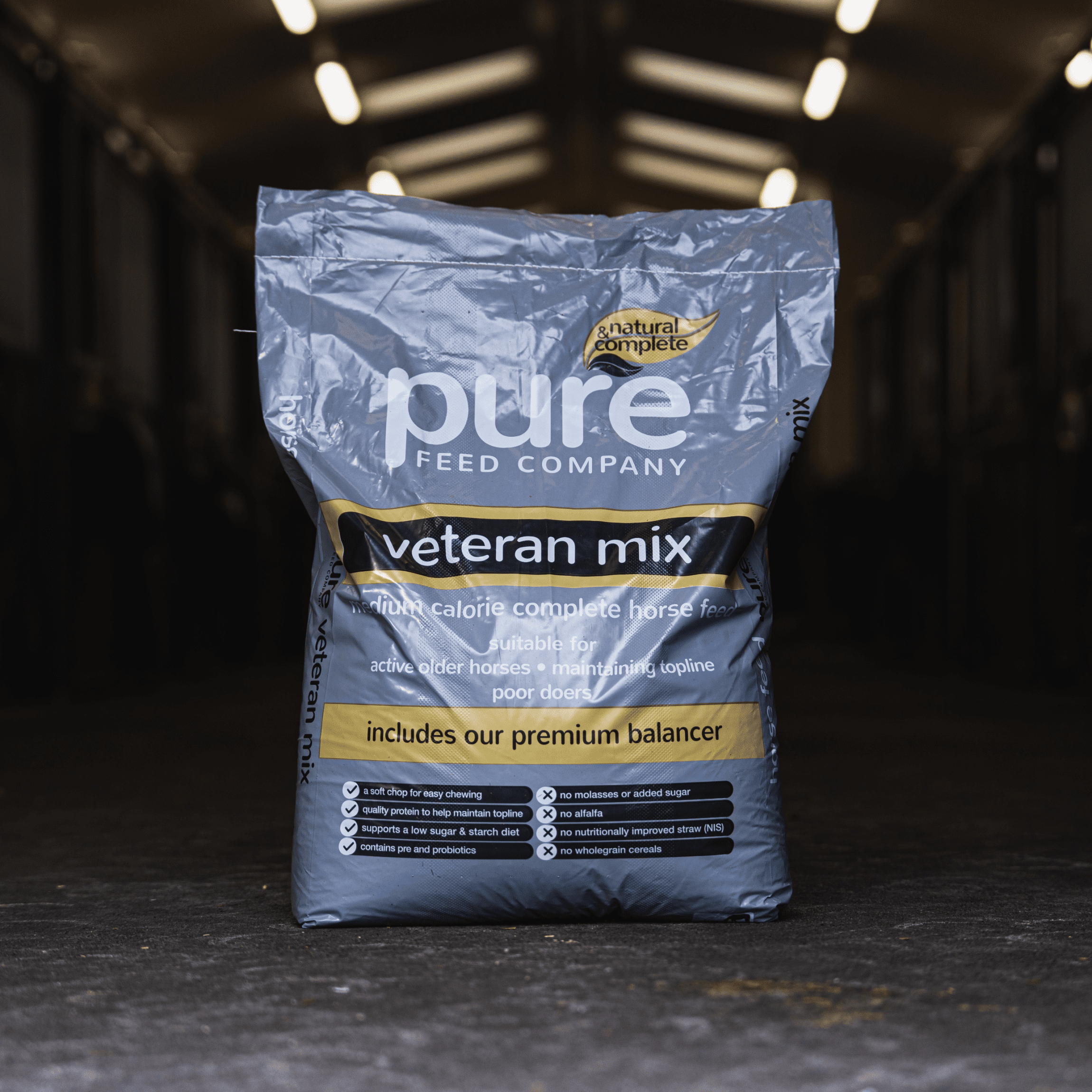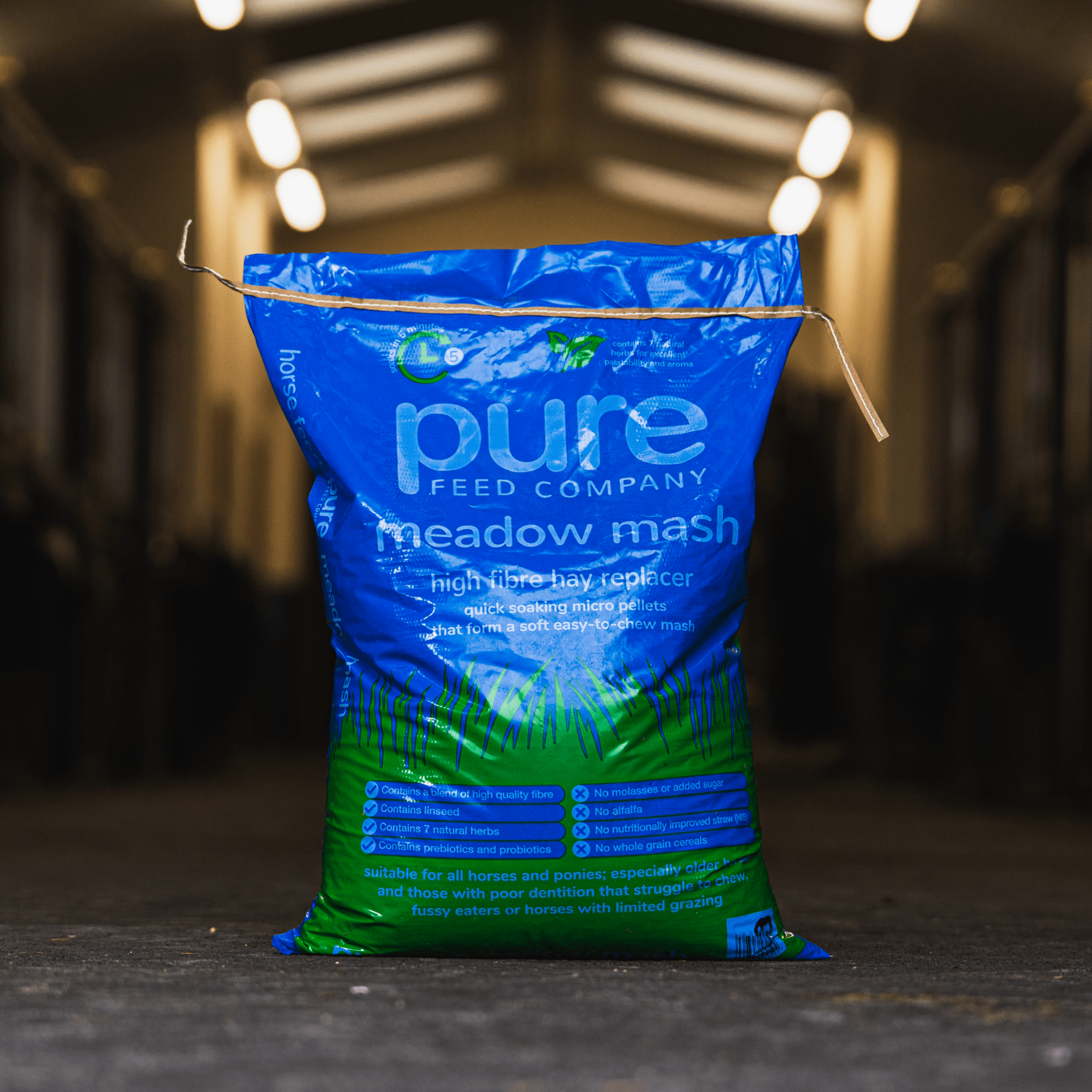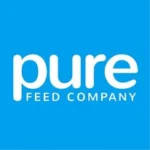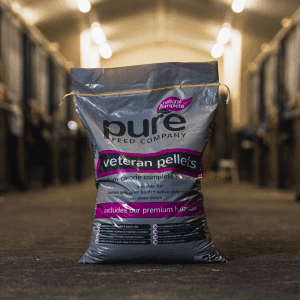FEED ADVICE – HEALTH
Colic in Horse: Understanding and Prevention Tips
Colic in horses is a term used to describe abdominal pain rather than a specific diagnosis. It can stem from various gastrointestinal conditions as well as other causes of abdominal pain not related to the gastrointestinal tract.
Key Highlights
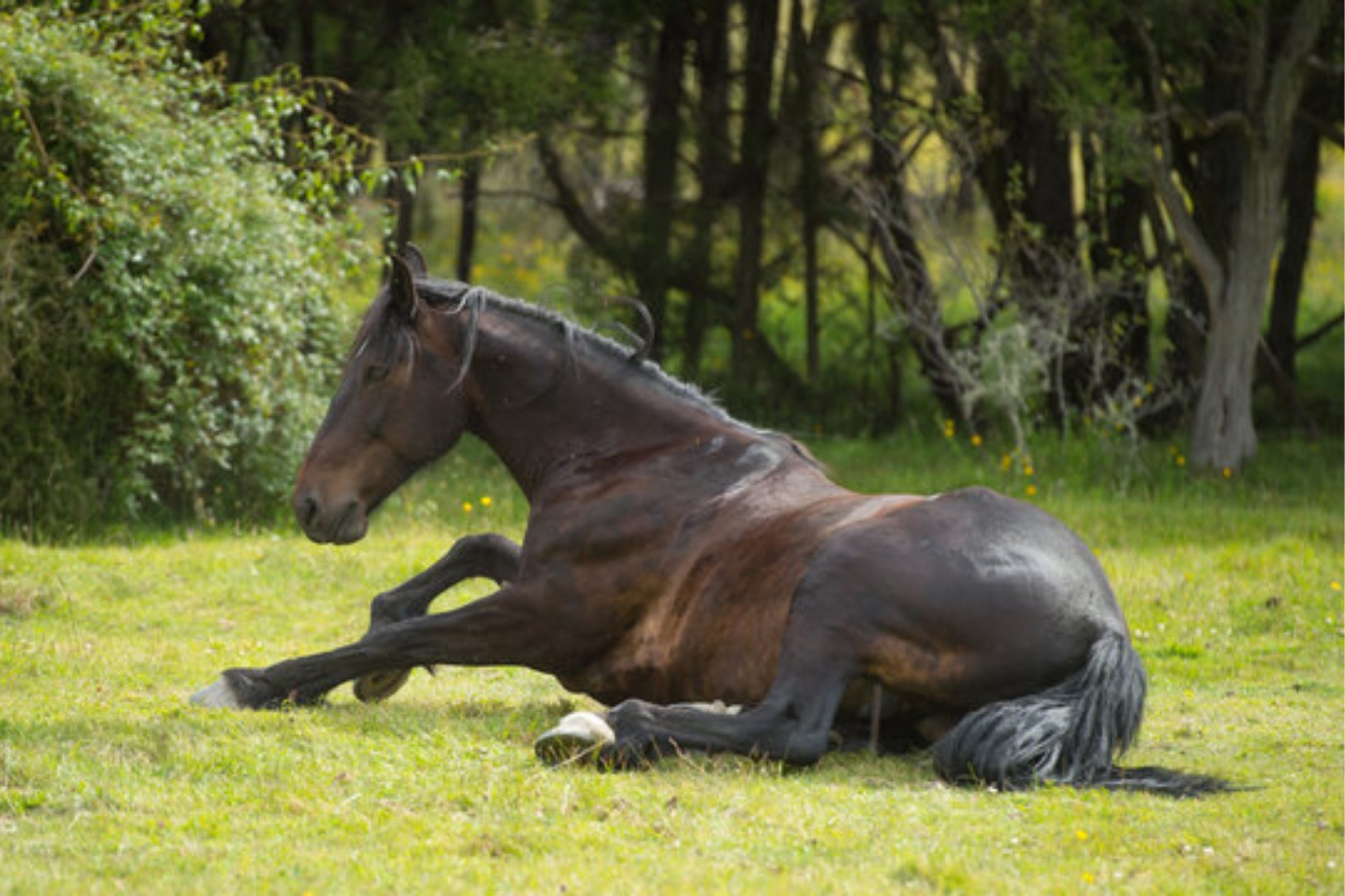
Colic in horses is defined as general abdominal pain and can encompass various different gastrointestinal conditions.
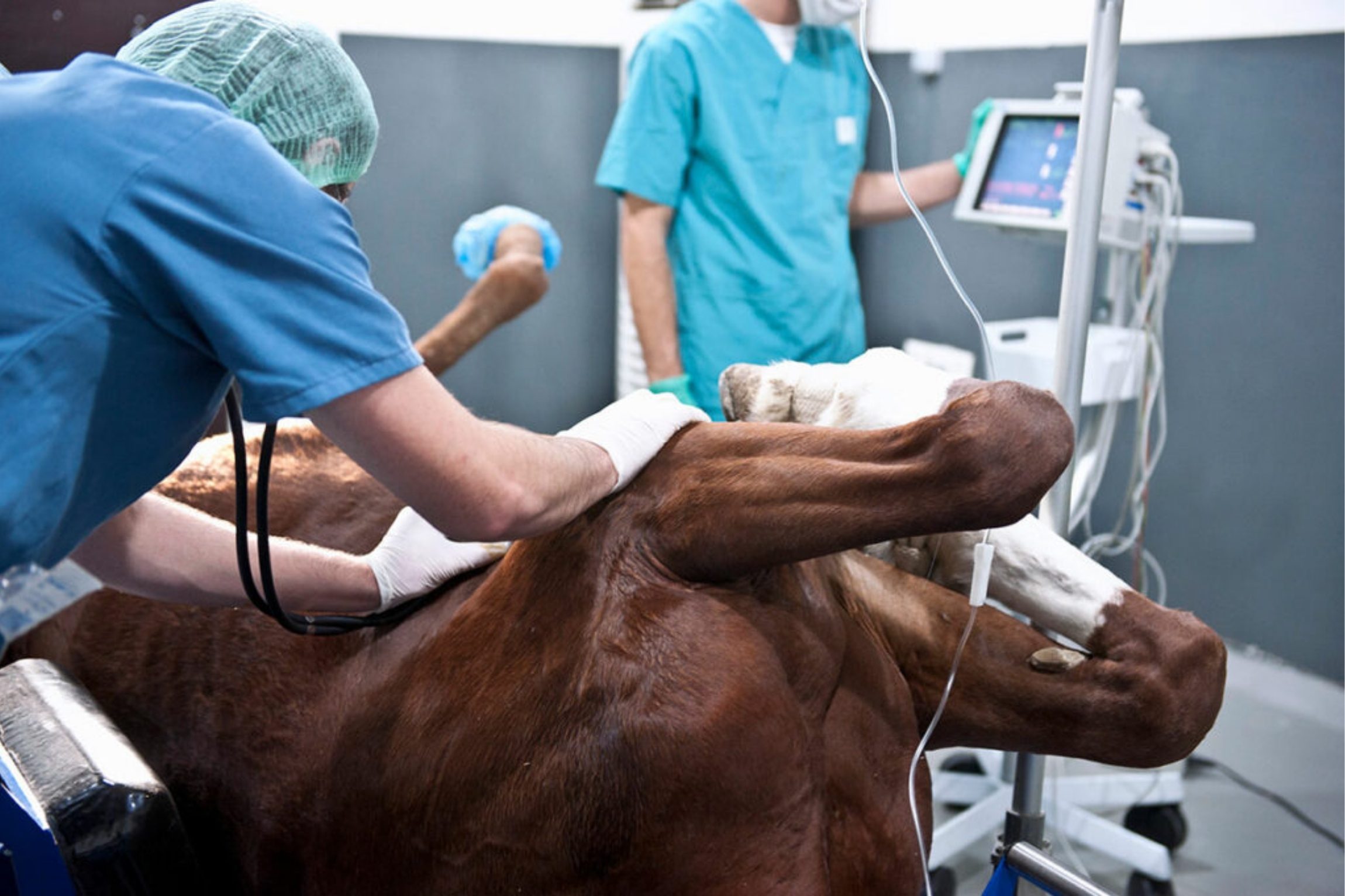
There are 6 defined types of colic which cover a broad spectrum of conditions.
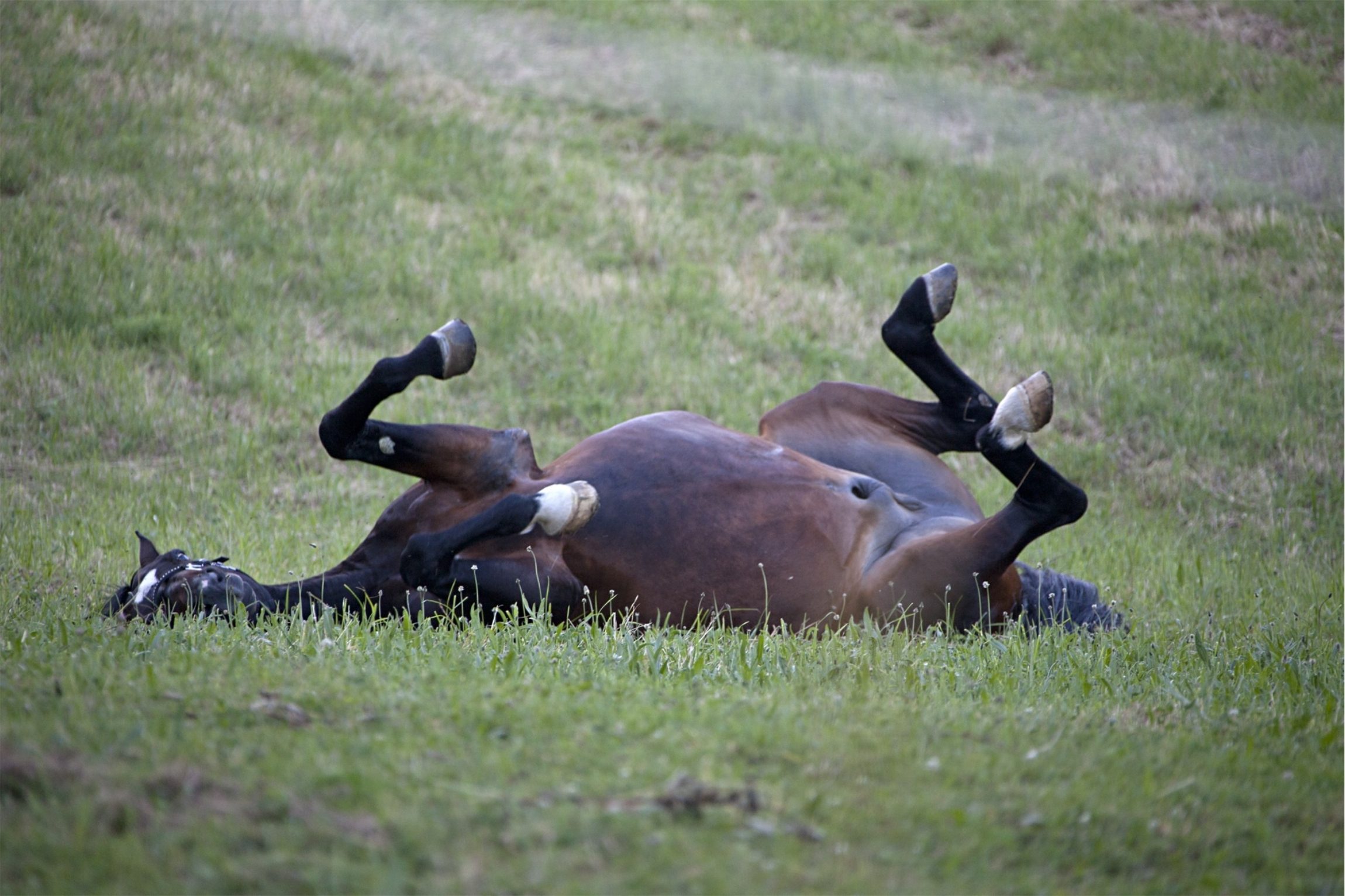
Common clinical signs include rolling, pawing, frequent glancing at the flank and an increased heart rate.
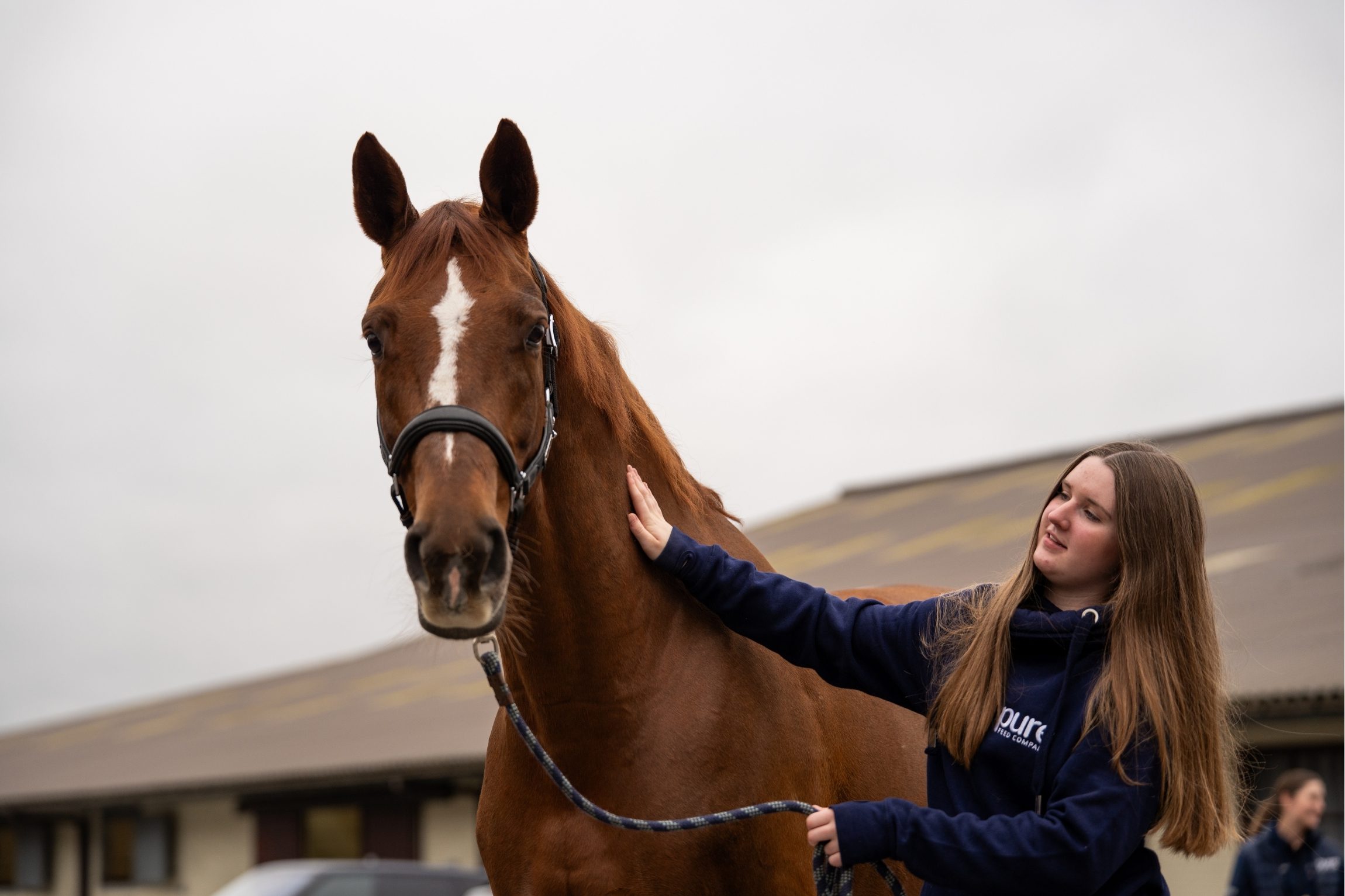
Rapid veterinary intervention is crucial, as colic can be fatal – early treatment can significantly improve the outcome and may prevent serious complications.
Understanding Colic
Colic in horses can stem from various causes, encompassing diet-related factors, stress, and environmental changes. Some of these factors include:
Dietary Factors: Rapid changes in type of feed or quantity, overconsumption of sugar, or feeding low-quality forage can disrupt the delicate balance of the digestive system, predisposing horses to colic.
Parasitic Infestation: Internal parasites, including tapeworms, pose a significant colic risk. Their presence can lead to inflammation, impaction, or obstruction of the intestines, contributing to colic episodes.
Grazing Management: Abrupt transitions from dry forage to lush pasture or inadequate turnout time can disrupt the horse’s digestive balance, leading to gastrointestinal upset and colic.
Stress and Environmental Factors: Horses are highly sensitive, and changes in routine, transportation, or confinement can induce stress, triggering colic symptoms. Additionally, environmental stressors such as extreme temperatures or social isolation can exacerbate the risk of colic.
Dental Health: Proper dental care is paramount for effective digestion in horses. Dental abnormalities, such as sharp points or malocclusions, can impede chewing and hinder the breakdown of feed particles, predisposing horses to colic.
Hydration Status: Inadequate water intake or dehydration can impair gastrointestinal motility, leading to impactions or sluggish bowel movements, common culprits of colic.

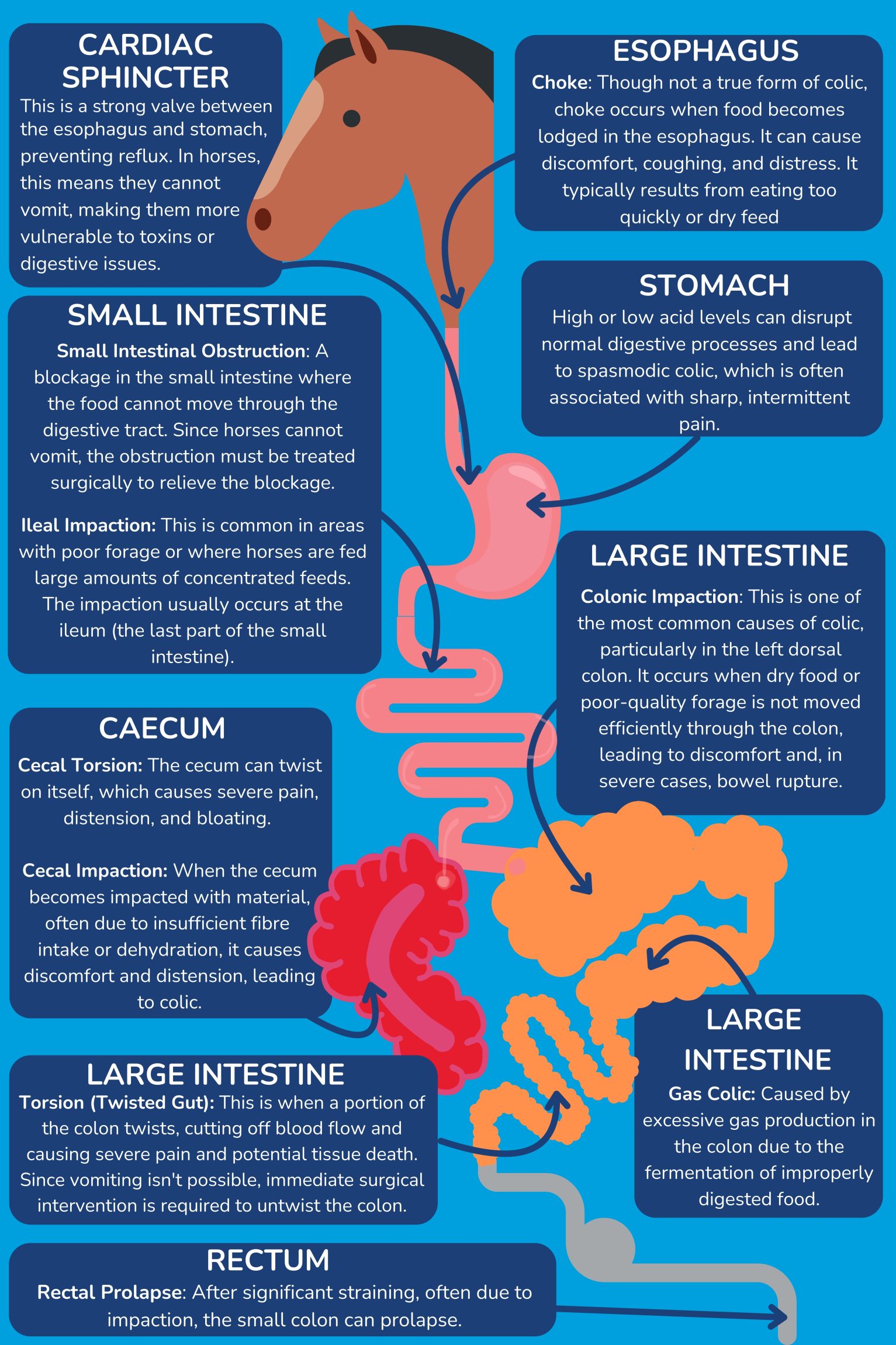
Types of Colic
There are 6 broad terms used to describe the different types of colic:
- Gas Colic: Characterised by the build-up of gas in the intestines, often due to fermentation of feed or sudden dietary changes. This accumulation causes distension and pain in the abdomen, typically manifesting as restlessness and discomfort in the affected horse.
- Impaction Colic: occurs when feed, sand, or other materials block the intestines, preventing normal passage. This blockage leads to severe abdominal pain, dehydration, and reduced appetite.
- Spasmodic Colic: caused by increased intestinal motility and muscle spasms, leading to intermittent and intense abdominal pain. It is often triggered by dietary changes, stress, or parasitic infections.
- Strangulation: occurs when the blood supply to a section of the intestine is cut off, often due to a twist or entrapment. This condition causes severe abdominal pain and rapid deterioration, necessitating emergency veterinary intervention and often surgery to prevent tissue death and further complications.
- Sand Colic: caused by the ingestion of sand or dirt, which accumulates in the horse’s intestines. This can lead to blockages, irritation, and inflammation, resulting in abdominal pain and discomfort.
- Displacement: occurs when a section of the intestine moves from its normal position, often causing a twist or blockage. This displacement can disrupt blood flow and digestion, leading to severe abdominal pain and requiring prompt veterinary intervention.
Recognising clinical signs of Colic
Behavioral changes and physical signs are crucial in recognising colic in horses.
Behavioural Changes:
Restlessness: The horse may appear anxious, pacing or unable to stand still.
Pawing: Repeatedly pawing at the ground is a common sign of discomfort.
Rolling: Horses with colic often roll to try and alleviate abdominal pain.
Sweating: Excessive sweating, particularly in the absence of exercise, is often a sign of distress.
Abdominal Stretching: The horse may stretch out as though trying to urinate, due to pain.
Lying Down and Standing Up: Repeatedly lying down and standing up can be a sign of discomfort and attempts to find relief.
Physical Changes:
Reduced or Absent Appetite: Horses with colic often refuse food or water due to pain.
Reduced or Absent Gut Sounds: A decrease or complete absence of gut sounds may indicate gut dysfunction.
Elevated Heart Rate: A heart rate above 48 beats per minute is a key indicator of colic-related distress.
Tachypnoea (Rapid Breathing): Breathing above 20 breaths per minute can signal pain or shock.
Temperature Changes: Normal body temperature ranges from 37.5°C to 38.5°C. A temperature drop below 37.0°C may indicate shock or severe colic.
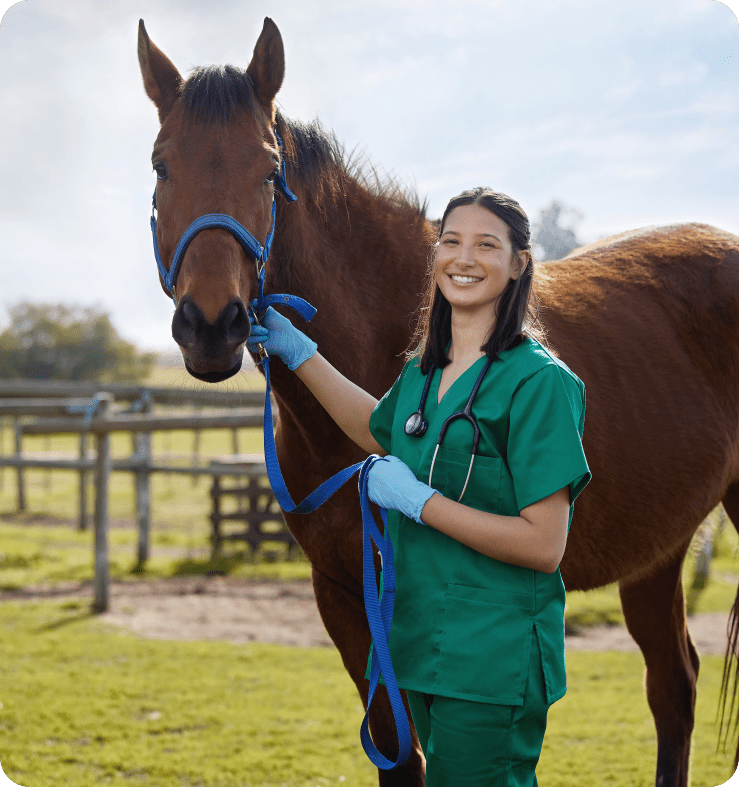
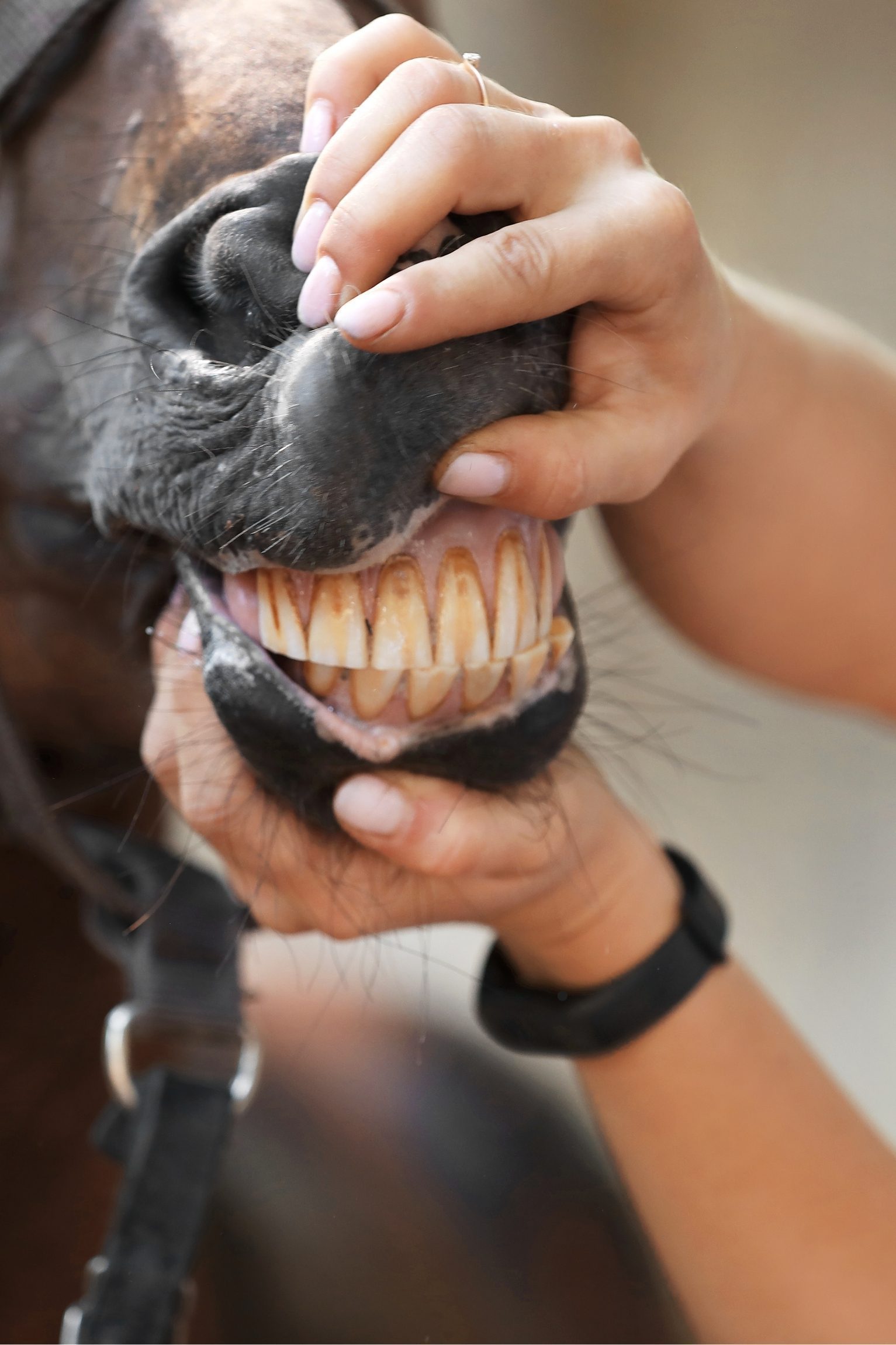
Diagnosis of Colic
Diagnostic procedures for colic involve thorough examinations by vets. Early and accurate diagnosis is essential for providing the correct treatment swiftly.
1. Initial Examination Steps
During the initial examination of a colic horse, veterinarians focus on assessing vital signs such as heart rate and respiratory rate, as well as the hydration status and signs of abdominal pain.
- Heart Rate: An elevated heart rate (over 50 beats per minute) can indicate pain and stress. Severe colic often results in a heart rate exceeding 70 beats per minute.
- Respiratory Rate: An increased respiratory rate can accompany pain and stress.
- Mucous Membrane Colour: Checking the colour and moisture of the gums can provide clues about circulation and hydration. Pale or blue-tinged gums can indicate poor circulation or shock.
- Capillary Refill Time: Pressing on the gums and measuring the time it takes for colour to return helps assess blood flow and hydration status.
A rectal examination is often performed to assess the condition of the gastrointestinal tract. This involves a veterinarian manually examining the horse’s rectum. This can help identify specific types of colic, such as impaction, displacement, or twisted intestines.
2. Diagnostic Tools and Their Importance
Diagnostic tools play a crucial role in identifying the underlying causes of colic in horses. Technologies like ultrasound, endoscopy, and radiography aid veterinarians in assessing the severity and determining the most effective treatment plan. These tools provide detailed insights into the horse’s gastrointestinal tract, blood supply, and any abnormalities that may be contributing to the abdominal pain.
Nasogastric Intubation:
A tube is passed through the horse’s nose into the stomach to relieve built-up gas and fluid. The presence of reflux (large amounts of fluid) can indicate a blockage or severe motility issue in the intestines. This procedure also allows for the administration of medications directly into the stomach.
Ultrasound and Radiography:
Ultrasound: Non-invasive imaging to visualise the intestines, assess motility, and identify abnormalities such as displacements, blockages, or excessive fluid.
Radiography: X-rays can be particularly useful for diagnosing sand colic by showing the presence of sand or other foreign materials in the intestines.
Blood Tests:
Blood tests help evaluate the horse’s overall health and pinpoint specific issues.
Complete Blood Count (CBC): Assesses for signs of infection or inflammation.
Serum Chemistry: Evaluates organ function and electrolyte balance.
Lactate Levels: Elevated lactate levels can indicate poor blood flow to the intestines, a sign of severe or strangulating colic.
Prompt and accurate diagnosis is essential for effective treatment and can significantly impact the horse’s prognosis. Veterinary intervention should be sought at the first signs of colic to ensure the best possible outcome.
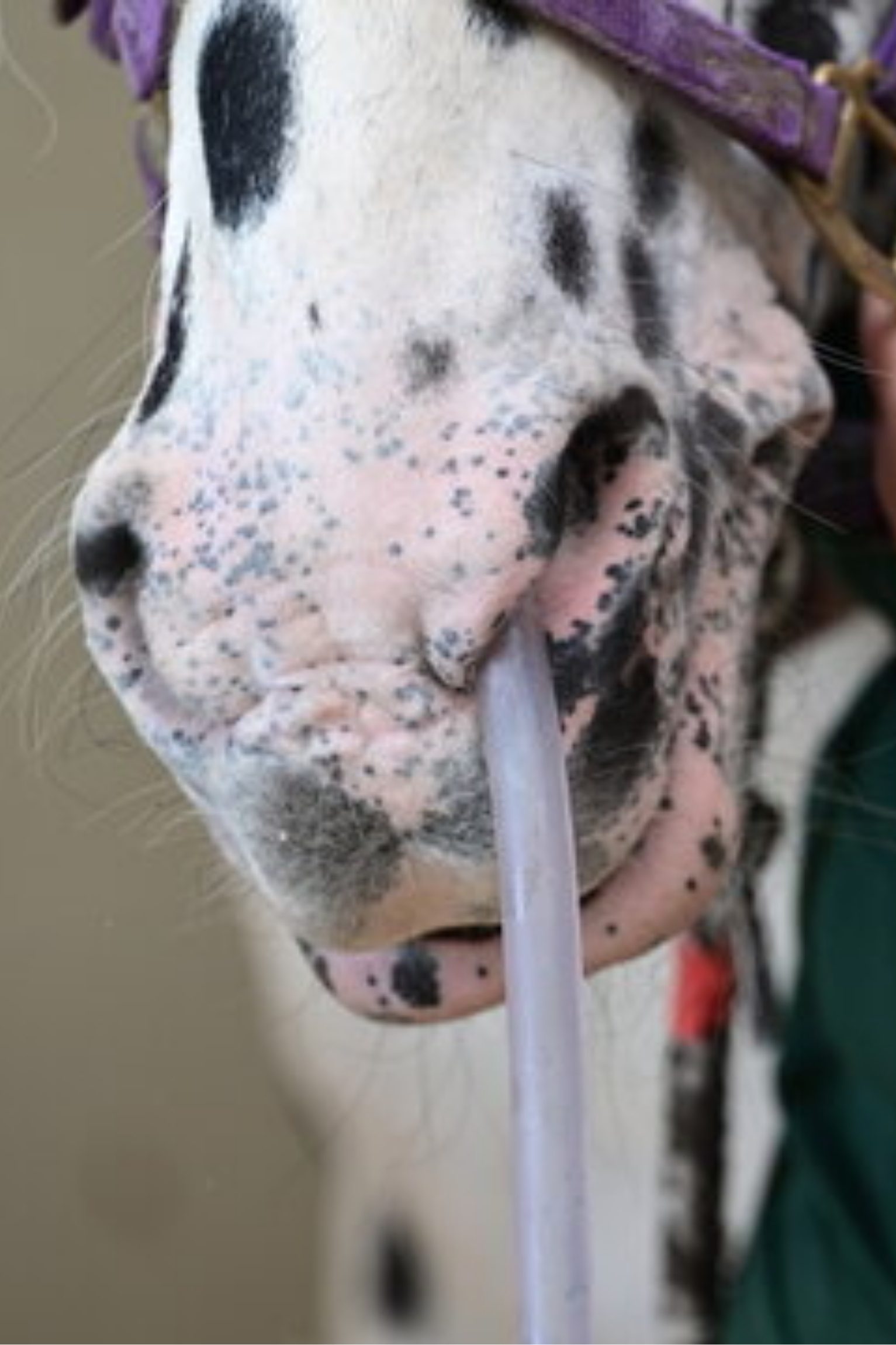
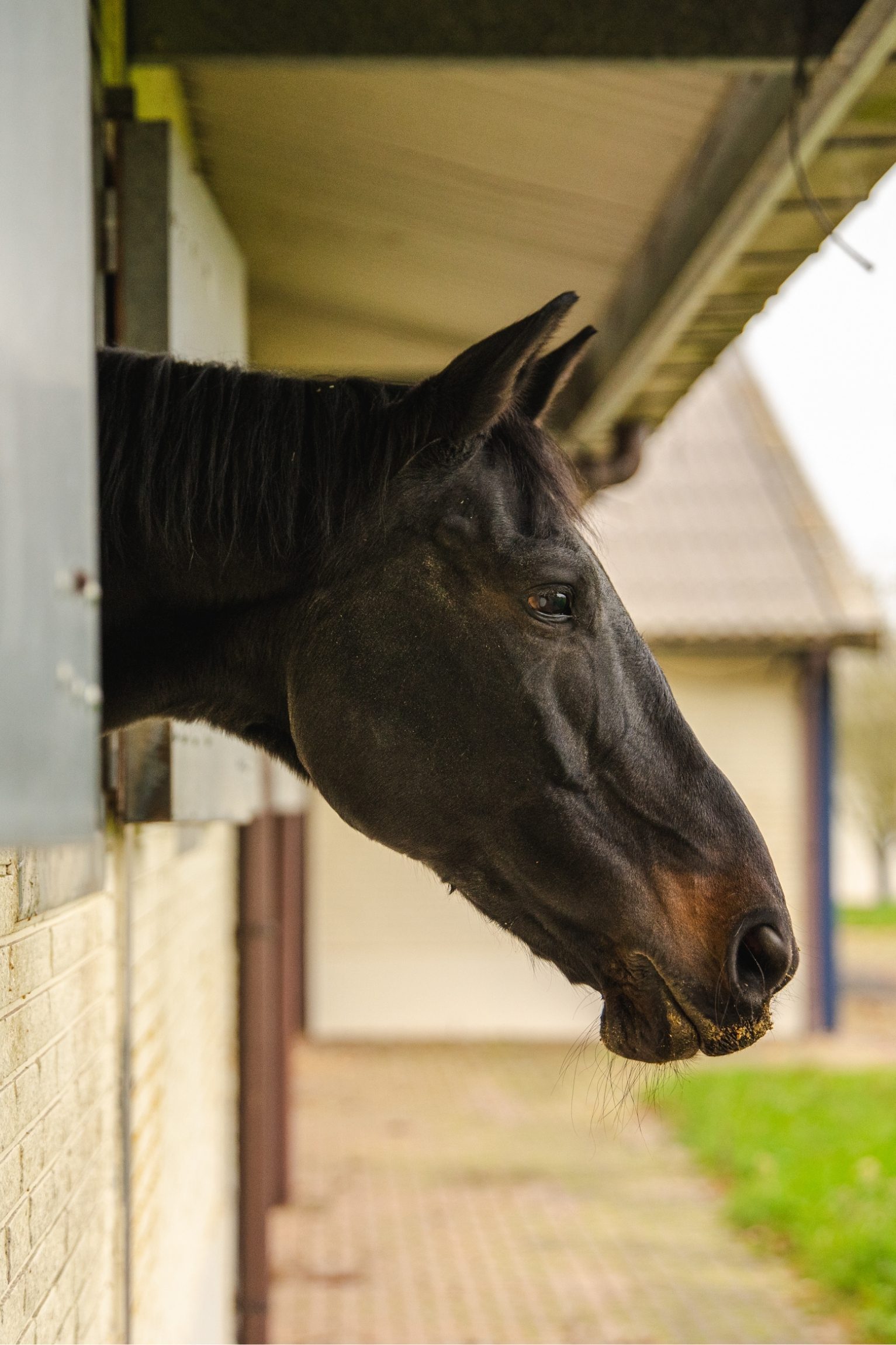
Treatment Options for Colic
The treatment for colic in horses depends on its severity and underlying cause. There are two main approaches: non-surgical management and surgical intervention.
Non-Surgical Management and Care
Non-surgical treatment focuses on pain relief, addressing dehydration, and managing the condition without surgery. The goal is to support the horse while avoiding invasive procedures when possible.
Fluid Therapy
Oral Fluids: Administered via a nasogastric tube to help rehydrate the horse and soften impactions.
Intravenous Fluids (IV): Used in severe cases to quickly correct dehydration and restore fluid balance.
Gastric Decompression
Repeated nasogastric intubation may be needed to relieve gas and fluid buildup in the stomach, particularly in cases of gas colic.
Controlled Walking
Helps stimulate intestinal motility and assists with the passage of gas or small impactions. However, excessive exercise should be avoided.
Dietary Management
Feed is temporarily withheld to allow the intestines to rest.
Small, easily digestible meals are gradually reintroduced as the horse shows improvement.
Medication Anti-Spasmodics: Drugs like Buscopan (hyoscine butylbromide) are used to relax intestinal spasms and relieve discomfort, particularly in cases of spasmodic colic.
Monitoring
Close observation of vital signs, such as heart rate, respiratory rate, and mucous membrane colour, is crucial to assess the horse’s response to treatment.
When Surgery Becomes a Necessity: What to Expect
If the horse does not improve with non-surgical management, or if it shows signs of severe distress, surgical intervention may be necessary. This could include:
Exploratory Abdominal Surgery: To investigate the cause of colic.
Intestinal Resection: Removing damaged sections of the intestine, if needed.
The primary surgical procedure is an exploratory laparotomy, where an incision is made into the abdomen to visually inspect the intestines. This allows veterinarians to identify the exact cause of colic, such as intestinal volvulus (twist), displacement, or strangulation. Depending on the findings, surgical corrections may include intestinal resection and anastomosis, where damaged portions of the intestine are removed and healthy ends reattached.
In cases of impaction, surgical decompression is necessary to relieve pressure and restore normal function. Surgical correction of intestinal strangulation is critical to untwist entrapped intestines and restore blood flow, preventing tissue death (necrosis) and further complications.
Post-surgical care involves intensive monitoring, pain management, fluid therapy, and careful reintroduction of food under veterinary supervision to ensure the horse’s recovery. Early detection and prompt surgical intervention significantly improve the chances of a successful outcome for horses suffering from colic.
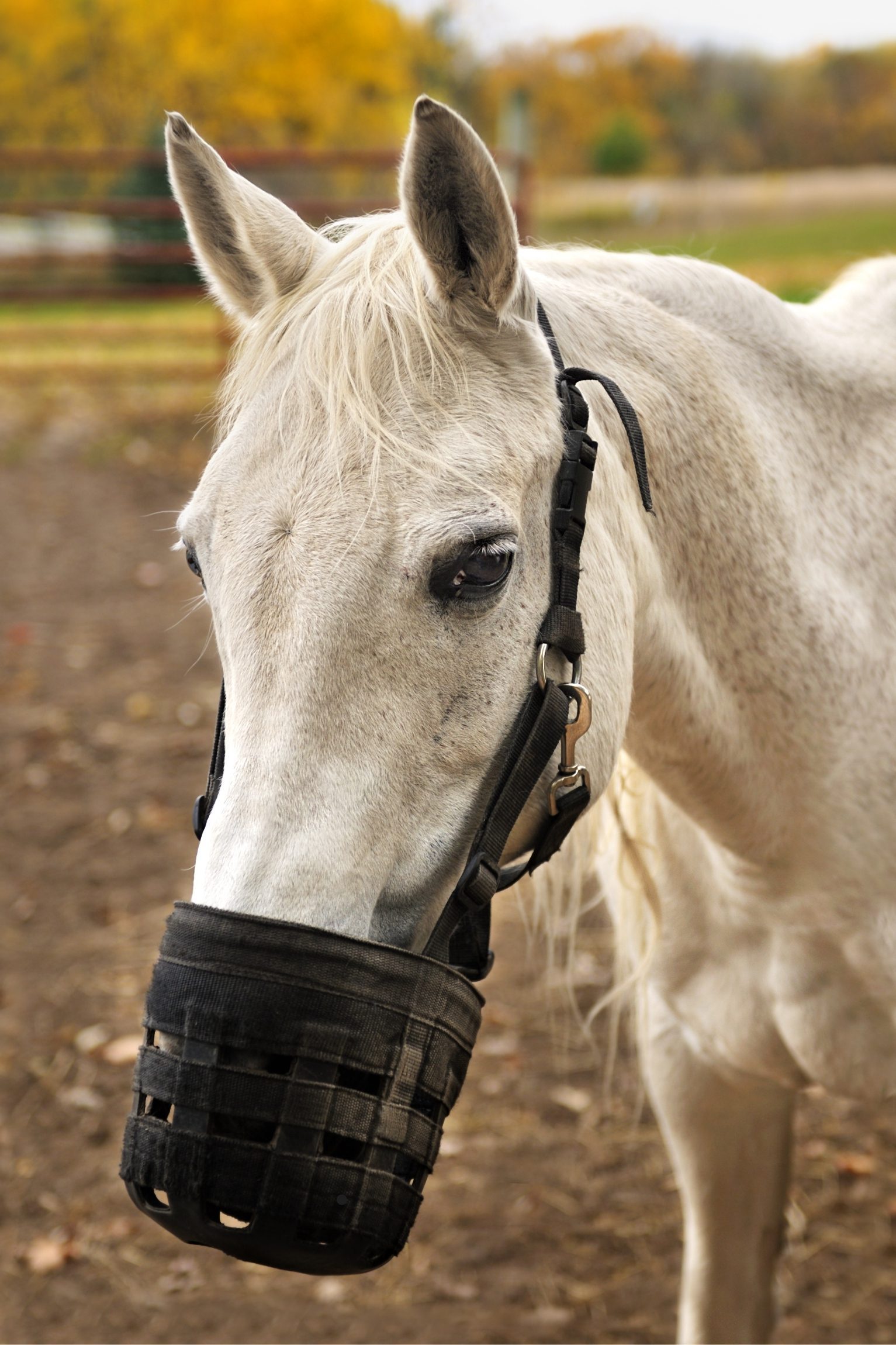

Preventative Measures Against Colic
Implementing preventative measures is crucial for preventing colic episodes. Key strategies include maintaining a consistent and balanced diet to prevent digestive issues. Avoid sudden dietary changes and ensure access to clean cold water. Regular exercise can also aid in promoting healthy gut function. Routine veterinary check-ups and proper dental care are essential. Additionally, controlling environmental factors such as stress and ensuring a suitable living environment can minimize the risk of colic.
Dietary Management and Feeding Practices
Implementing proper dietary management and feeding practices is crucial in preventing colic in horses. Key strategies include:
- Balanced Diets: Providing horses with well-balanced diets rich in high-quality forage, essential nutrients, and adequate fibre content promotes optimal gastrointestinal health and reduces the risk of digestive disturbances.
- Gradual Diet Transitions: Abrupt changes in feed composition or quantity should be avoided, as they can disrupt the delicate microbial ecosystem within the gut and predispose horses to colic – did you know that all Pure Feed’s complete feeds share the same core ingredients? This means you can switch between all of the complete feeds with no transition time without risking colic!
- Forage Management: Regular access to clean, quality forage supports proper digestion, maintains gut motility, and minimizes the risk of impaction colic.
- Supplements: using probiotics, prebiotics, and digestive enzymes can support gastrointestinal health, enhance nutrient absorption, and fortify the gut barrier function – did you know all of our complete feeds already contain pre and probiotics to make sure your horse’s digestive system is supported!
- Hydration Maintenance: Adequate water intake is essential for optimal digestive function and overall well-being. Monitoring water availability and quality ensures horses remain adequately hydrated, mitigating the risk of colic associated with dehydration – Check out our Meadow Mash or ReFuel if your horse needs help drinking!
Routine Health Care and Monitoring
Regular and routine healthcare and monitoring are essential components of effective horse management to prevent and promptly detect colic. Establishing and adhering to a consistent healthcare regimen, which includes regular dental check-ups, deworming schedules, and vaccinations, is crucial. Monitoring vital signs such as temperature, heart rate, and gut sounds on a regular basis facilitates early detection of colic. It’s important to be familiar with your horse’s baseline values to accurately assess any deviations.
Conclusion
In summary, colic poses a serious health risk to horses, demanding proactive care and attentive management from owners. Swift recognition of symptoms, immediate veterinary attention, and consistent preventive measures are crucial for preventing colic episodes. By being consistent with healthcare routines such as worming, ensuring balanced nutrition, and closely monitoring behaviour and vital signs, owners can effectively reduce the likelihood and severity of colic episodes, promoting the long-term health and happiness of their horses.
Featured products for horses prone to colic
Made in the UK
We are proud to say that all of our feeds are produced here in the UK
FREE Shipping
We offer FREE SHIPPING for all orders in the UK with 15 bags and over*
Sustainable
We are dedicated to playing our part in making the world more sustainable

100% Natural
We use high-quality ingredients and no unnecessary additives.
Thousands of people love our feeds
Why do so many horses drop weight in winter? ❄️ Let us tell you why ...
🔥 Colder temps = more calories needed
Once it’s below 0–5°C, your horse needs extra energy just to stay warm. If their diet doesn’t cover it, they’ll burn fat reserves instead.
🌾 Forage isn’t as rich as summer grass
Hay and haylage have less energy & fewer vitamins than fresh grass, even if the net looks full.
🦠 Gut microbes have to adapt
Switching from grass to hay changes the gut bacteria, meaning they might get less usable energy from the same amount of forage.
💨 Energy goes to heat, not weight
More calories are spent on staying warm, especially if they’re still in work.
🏠 Routine changes matter
Less turnout, more stabling, and longer gaps between meals can all affect digestion & condition.
What helps?
✔️ Ad-lib forage to keep the gut working & generating heat
✔️ Slow-release calories from unmolassed beet, grass fibres or oil
✔️ Vitamin & mineral balance to make up for forage shortfalls
✔️ Check body condition every 2–3 weeks
Our complete feeds are designed to tackle exactly these winter challenges. Each one provides:
✅ Fibre for gut support and heat generation
✅ Oil for steady, slow-release energy
✅ A full balancer with vitamins and minerals (no extra bucket needed!)
So even when winter forage is variable, you know your horse’s diet is still balanced — and their condition is supported right through to spring.
To find the right feed for your horse, head on over to www.purefeed.com to claim your FREE personalised diet plan, created by our nutrition team 🩵
#thepurefeedcompany #purefeed #equinenutrition #allyoufeedislove

Why do so many horses drop weight in winter? ❄️ Let us tell you why ...
🔥 Colder temps = more calories needed
Once it’s below 0–5°C, your horse needs extra energy just to stay warm. If their diet doesn’t cover it, they’ll burn fat reserves instead.
🌾 Forage isn’t as rich as summer grass
Hay and haylage have less energy & fewer vitamins than fresh grass, even if the net looks full.
🦠 Gut microbes have to adapt
Switching from grass to hay changes the gut bacteria, meaning they might get less usable energy from the same amount of forage.
💨 Energy goes to heat, not weight
More calories are spent on staying warm, especially if they’re still in work.
🏠 Routine changes matter
Less turnout, more stabling, and longer gaps between meals can all affect digestion & condition.
What helps?
✔️ Ad-lib forage to keep the gut working & generating heat
✔️ Slow-release calories from unmolassed beet, grass fibres or oil
✔️ Vitamin & mineral balance to make up for forage shortfalls
✔️ Check body condition every 2–3 weeks
Our complete feeds are designed to tackle exactly these winter challenges. Each one provides:
✅ Fibre for gut support and heat generation
✅ Oil for steady, slow-release energy
✅ A full balancer with vitamins and minerals (no extra bucket needed!)
So even when winter forage is variable, you know your horse’s diet is still balanced — and their condition is supported right through to spring.
To find the right feed for your horse, head on over to www.purefeed.com to claim your FREE personalised diet plan, created by our nutrition team 🩵
#thepurefeedcompany #purefeed #equinenutrition #allyoufeedislove
🚫 STOP FEEDING SUPERMARKET OILS ‼️
Adding vegetable oil for extra condition or coat shine might seem harmless — but the fatty acid balance is all wrong for horses.
🔸 Horses need both omega-3 (ALA) and omega-6 (LA) — but the ratio is what matters.
Here’s how common oils stack up against grass 👇
🌿 Grass ≈ 3–4:1 (omega-3:omega-6)
🌱 Linseed ≈ 4:1
🥥 Coconut ≈ 1:2
🌰 Soya ≈ 1:7
🌽 Corn ≈ 1:50
🌻 Sunflower ≈ 1:200
An excess of omega-6 can:
❌ Increase pro-inflammatory compounds
❌ Slow recovery after exercise
❌ Exacerbate gut sensitivity
❌ Add strain to joints
✨ Linseed is naturally rich in omega-3, helping restore balance in hay- and cereal-based diets. It supports anti-inflammatory pathways, a glossy coat, healthy skin, and cell function.
💜 Pure Linseed is 100% micronised linseed — highly digestible, naturally high in oil for slow-release energy, a great fibre source, and close to the horse’s natural omega ratio.
👉 Head to our website to learn more about Pure Linseed.
#purefeed #thepurefeedcompany #purelinseed

🚫 STOP FEEDING SUPERMARKET OILS ‼️
Adding vegetable oil for extra condition or coat shine might seem harmless — but the fatty acid balance is all wrong for horses.
🔸 Horses need both omega-3 (ALA) and omega-6 (LA) — but the ratio is what matters.
Here’s how common oils stack up against grass 👇
🌿 Grass ≈ 3–4:1 (omega-3:omega-6)
🌱 Linseed ≈ 4:1
🥥 Coconut ≈ 1:2
🌰 Soya ≈ 1:7
🌽 Corn ≈ 1:50
🌻 Sunflower ≈ 1:200
An excess of omega-6 can:
❌ Increase pro-inflammatory compounds
❌ Slow recovery after exercise
❌ Exacerbate gut sensitivity
❌ Add strain to joints
✨ Linseed is naturally rich in omega-3, helping restore balance in hay- and cereal-based diets. It supports anti-inflammatory pathways, a glossy coat, healthy skin, and cell function.
💜 Pure Linseed is 100% micronised linseed — highly digestible, naturally high in oil for slow-release energy, a great fibre source, and close to the horse’s natural omega ratio.
👉 Head to our website to learn more about Pure Linseed.
#purefeed #thepurefeedcompany #purelinseed
Feeding Rates of Pure Sud explained ... Swipe to see how much Stud your horse should be eating ➡️
Why Pure Stud:
🩷 Supports sound bone development.🩷 Low starch content encourages positive behaviour.
🩷 Great value way of giving young and breeding horses everything they need nutritionally.
🩷 High in fibre for excellent digestive health.
🩷 A tasty choice – horses love it
If you have any questions, don’t hesitate to get in touch!
You can also request a personalised diet plan for free. Our team of expert nutritionists will carefully evaluate your horse, assess their unique nutritional needs, and provide the best feeding recommendations to help them look and feel their best. Available on our website!
📞 01458 333 333
💻 www.purefeed.com
💬 Direct Message us
#thepurefeedcompany #purestud #feedingrates #allyoufeedislove #purefeed

Feeding Rates of Pure Sud explained ... Swipe to see how much Stud your horse should be eating ➡️
Why Pure Stud:
🩷 Supports sound bone development.🩷 Low starch content encourages positive behaviour.
🩷 Great value way of giving young and breeding horses everything they need nutritionally.
🩷 High in fibre for excellent digestive health.
🩷 A tasty choice – horses love it
If you have any questions, don’t hesitate to get in touch!
You can also request a personalised diet plan for free. Our team of expert nutritionists will carefully evaluate your horse, assess their unique nutritional needs, and provide the best feeding recommendations to help them look and feel their best. Available on our website!
📞 01458 333 333
💻 www.purefeed.com
💬 Direct Message us
#thepurefeedcompany #purestud #feedingrates #allyoufeedislove #purefeed
We were delighted to hear from Bronnen about her love for Pure Easy 💚
"I have used your feed for about the last 10 years with all the horses and ponies I’ve had. I have an event mare that we have been struggling with soundness issues for the last 2 years so has barely been in work. We never made it out of walk in the last 2 years, yet this is her this morning, fed on pure easy, looking absolutely incredible, like she hasn’t seen a day out of work in her life! Love your feeds so much, thank you! I always recommend you to anyone who asks. I have a young Connie too who is just starting her ridden career and they are both on pure easy. So simple and easy to use and I trust it to support muscle development without any extra energy than they need. Big fan!"
Have you had a Pure Feed success story of your own? We’d love to hear it! Share your experience with us in the comments or tag us in your posts - your horse could be featured next!
Thank you Bronnen for taking the time to get in touch 🙌 @bronnen_equestrian
#thepurefeedcompany #purefeed #allyoufeedislove #poweredbypurefeed

We were delighted to hear from Bronnen about her love for Pure Easy 💚
"I have used your feed for about the last 10 years with all the horses and ponies I’ve had. I have an event mare that we have been struggling with soundness issues for the last 2 years so has barely been in work. We never made it out of walk in the last 2 years, yet this is her this morning, fed on pure easy, looking absolutely incredible, like she hasn’t seen a day out of work in her life! Love your feeds so much, thank you! I always recommend you to anyone who asks. I have a young Connie too who is just starting her ridden career and they are both on pure easy. So simple and easy to use and I trust it to support muscle development without any extra energy than they need. Big fan!"
Have you had a Pure Feed success story of your own? We’d love to hear it! Share your experience with us in the comments or tag us in your posts - your horse could be featured next!
Thank you Bronnen for taking the time to get in touch 🙌 @bronnen_equestrian
#thepurefeedcompany #purefeed #allyoufeedislove #poweredbypurefeed
Worried about Winter fizz, but your horse needs to gain weight?
It’s a situation we hear all the time, especially in winter when horses need more calories to maintain condition, but no one wants a fizzy, unrideable horse.
Fast-release energy mainly comes from starch and sugars (found in cereals like oats, barley, maize). These are broken down in the small intestine into glucose, which causes a rapid rise in blood sugar. Result? A quick burst of energy, often linked with sharper behaviour or “fizz”.
Slow-release energy comes from fibre and oil. Fibre is fermented in the hindgut by microbes into volatile fatty acids (VFAs), while oil is broken down into fatty acids in the small intestine. Both provide a steady, sustained fuel source without the glucose spikes. Result? More stamina, better weight maintenance, and a calmer, more consistent way of providing calories.
Why does this matter in winter?
Many horses lose condition as the cold increases calorie demand. Owners worry about upping feed in case it makes their horse hot, but if the calories come from slow-release sources, they can safely support condition without unwanted fizz.
Our Condition Mix is built on fibre, oil, and unmolassed beet, not high-starch cereals. That means it delivers the extra calories your horse needs for condition in a controlled, slow-release form. Energy for weight maintenance and work, without the behaviour spike.
💬 Want us to create a tailored winter feeding plan for your horse? Comment “DIET PLAN” below and we’ll be in touch!
#thepurefeedcompany #purefeed #equinenutrition #allyoufeedislove
📸 @joelsebhart @ruthpotterpr

Worried about Winter fizz, but your horse needs to gain weight?
It’s a situation we hear all the time, especially in winter when horses need more calories to maintain condition, but no one wants a fizzy, unrideable horse.
Fast-release energy mainly comes from starch and sugars (found in cereals like oats, barley, maize). These are broken down in the small intestine into glucose, which causes a rapid rise in blood sugar. Result? A quick burst of energy, often linked with sharper behaviour or “fizz”.
Slow-release energy comes from fibre and oil. Fibre is fermented in the hindgut by microbes into volatile fatty acids (VFAs), while oil is broken down into fatty acids in the small intestine. Both provide a steady, sustained fuel source without the glucose spikes. Result? More stamina, better weight maintenance, and a calmer, more consistent way of providing calories.
Why does this matter in winter?
Many horses lose condition as the cold increases calorie demand. Owners worry about upping feed in case it makes their horse hot, but if the calories come from slow-release sources, they can safely support condition without unwanted fizz.
Our Condition Mix is built on fibre, oil, and unmolassed beet, not high-starch cereals. That means it delivers the extra calories your horse needs for condition in a controlled, slow-release form. Energy for weight maintenance and work, without the behaviour spike.
💬 Want us to create a tailored winter feeding plan for your horse? Comment “DIET PLAN” below and we’ll be in touch!
#thepurefeedcompany #purefeed #equinenutrition #allyoufeedislove
📸 @joelsebhart @ruthpotterpr
Looking for Pure Feed in Rugby?
Or ready to switch to a simpler, more natural way of feeding?
We’re thrilled to announce that Tower Farm Saddlery is now stocking Pure Feed 🎉
Our complete feeds combine fibre, balancer, and oil in one convenient bag, giving your horse everything they need while saving you time and effort.
📍 Head to our Stockist Map to find Tower Farm and your nearest stockist: https://www.purefeed.com/stockists/

Looking for Pure Feed in Rugby?
Or ready to switch to a simpler, more natural way of feeding?
We’re thrilled to announce that Tower Farm Saddlery is now stocking Pure Feed 🎉
Our complete feeds combine fibre, balancer, and oil in one convenient bag, giving your horse everything they need while saving you time and effort.
📍 Head to our Stockist Map to find Tower Farm and your nearest stockist: https://www.purefeed.com/stockists/
We had a fantastic time at the Pony Tales Annual Charity Day in support of World Horse Welfare 🐴
Our giveaway winner, Abi, joined us for the day looking incredibly smart in her Pure Feed merchandise! 🩵
Together, the event raised an amazing £10,252 for charity! 🤩
Thank you to Pony Tales for letting us be part of such a special day, and we hope Abi & Dilly had a wonderful time!
@ponytalesdorset @horsecharity
#thepurefeedcompany #purefeed #allyoufeedislove #worldhorsewelfare #ponytalesdorset #charityday #fundraiser

We had a fantastic time at the Pony Tales Annual Charity Day in support of World Horse Welfare 🐴
Our giveaway winner, Abi, joined us for the day looking incredibly smart in her Pure Feed merchandise! 🩵
Together, the event raised an amazing £10,252 for charity! 🤩
Thank you to Pony Tales for letting us be part of such a special day, and we hope Abi & Dilly had a wonderful time!
@ponytalesdorset @horsecharity
#thepurefeedcompany #purefeed #allyoufeedislove #worldhorsewelfare #ponytalesdorset #charityday #fundraiser
What’s really going on when your horse has Cushing’s? 🐴
Cushing’s (properly called Pituitary Pars Intermedia Dysfunction – PPID) is a progressive condition affecting the pituitary gland in your horse’s brain.
In a normal horse, this gland helps control hormones like ACTH, which regulate cortisol (the stress hormone).
When a horse has PPID, the pituitary gland control system breaks down, and too much ACTH is released, resulting in high cortisol levels (aka high stress levels!)
This can affect:
🩵 Metabolism
🩵 Immune system
🩵 Tissue repair
📌 Key facts:
Most common in horses 15+ but can appear earlier
Not curable, but can be managed with the right vet care, diet & management
Spotting early signs like subtle coat or behaviour changes is important
A simple ACTH blood test via your vet can confirm 💡
With the right support, horses with PPID can still live active, happy lives for many years.
All of the Pure Feed range is suitable for horses with his condition (excluding Pure Performance). For an in-depth guide to feeding your horse, apply for a free personalised diet plan today on our website.
#thepurefeedcompany #purefeed #equinenutrition #ppid #cushingsdisease #ppidsupport

What’s really going on when your horse has Cushing’s? 🐴
Cushing’s (properly called Pituitary Pars Intermedia Dysfunction – PPID) is a progressive condition affecting the pituitary gland in your horse’s brain.
In a normal horse, this gland helps control hormones like ACTH, which regulate cortisol (the stress hormone).
When a horse has PPID, the pituitary gland control system breaks down, and too much ACTH is released, resulting in high cortisol levels (aka high stress levels!)
This can affect:
🩵 Metabolism
🩵 Immune system
🩵 Tissue repair
📌 Key facts:
Most common in horses 15+ but can appear earlier
Not curable, but can be managed with the right vet care, diet & management
Spotting early signs like subtle coat or behaviour changes is important
A simple ACTH blood test via your vet can confirm 💡
With the right support, horses with PPID can still live active, happy lives for many years.
All of the Pure Feed range is suitable for horses with his condition (excluding Pure Performance). For an in-depth guide to feeding your horse, apply for a free personalised diet plan today on our website.
#thepurefeedcompany #purefeed #equinenutrition #ppid #cushingsdisease #ppidsupport
Are you worried about hay shortages, quality or price?
This year, we’re hearing the same thing from yards across the country:
🔹 Lower hay yields
🔹 Skyrocketing prices
🔹 Bales arriving late or not at all
🔹 And when they do? Inconsistent quality and unpredictable sugar levels
All of this makes it harder to manage your horse’s diet especially if they’re sensitive, on soaked forage, or prone to weight loss.
That’s where Pure Meadow Mash steps in.
🌿 Made from super fibres, it provides a highly digestible, low-sugar source of fibre, calories and hydration, no surprises, no stress.
Unlike hay, which can vary in protein, sugar, and digestibility depending on the cut, weather and storage, Pure Meadow Mash delivers consistent, controlled nutrition in every bowl.
Why choose it?
✔️ A reliable forage replacer; perfect if hay is in short supply or poor quality
✔️ Very low sugar and starch; suitable for laminitics, PPID and EMS
✔️ Soft, soaked fibre; ideal for older horses, dental issues or fussy eaters
✔️ Supports digestion and hydration; especially valuable in cold weather when horses drink less
It’s everything we wish hay could be this year: consistent, balanced, and ready when you need it.
Learn more about Pure Feed Meadow Mash on our website (link in bio 💻)
#purefeed #equinenutrition #allyoufeedislove #meadowmash

Are you worried about hay shortages, quality or price?
This year, we’re hearing the same thing from yards across the country:
🔹 Lower hay yields
🔹 Skyrocketing prices
🔹 Bales arriving late or not at all
🔹 And when they do? Inconsistent quality and unpredictable sugar levels
All of this makes it harder to manage your horse’s diet especially if they’re sensitive, on soaked forage, or prone to weight loss.
That’s where Pure Meadow Mash steps in.
🌿 Made from super fibres, it provides a highly digestible, low-sugar source of fibre, calories and hydration, no surprises, no stress.
Unlike hay, which can vary in protein, sugar, and digestibility depending on the cut, weather and storage, Pure Meadow Mash delivers consistent, controlled nutrition in every bowl.
Why choose it?
✔️ A reliable forage replacer; perfect if hay is in short supply or poor quality
✔️ Very low sugar and starch; suitable for laminitics, PPID and EMS
✔️ Soft, soaked fibre; ideal for older horses, dental issues or fussy eaters
✔️ Supports digestion and hydration; especially valuable in cold weather when horses drink less
It’s everything we wish hay could be this year: consistent, balanced, and ready when you need it.
Learn more about Pure Feed Meadow Mash on our website (link in bio 💻)
#purefeed #equinenutrition #allyoufeedislove #meadowmash
✨ GIVEAWAY TIME! ✨
We’re giving you the chance to win the ultimate Pure Feed look - our always popular, highly sought-after kit! 🐴💛
The Prize includes:
• The legendary Pure Feed branded Stormtech gilet
• Exclusive money-can’t-buy Pure Feed branded Le Mieux saddle pad (in cc or dr)
• £20 Pure Feed voucher towards your horse’s favourite feed
How to enter:
1️⃣ Make sure you’re following @thepurefeedcompany
2️⃣ Tag a friend in the comments (each new comment with a tag counts as an entry!)
📅 The winner will be announced on the 30th September
🏆 The winner will be picked at random and contacted directly by us
🇬🇧 UK entries only
This giveaway is in no way sponsored, endorsed, administered by, or associated with Instagram or Meta.
Good luck 🍀
#thepurefeedcompany #purefeed #allyoufeedislove #equinegiveaway

✨ GIVEAWAY TIME! ✨
We’re giving you the chance to win the ultimate Pure Feed look - our always popular, highly sought-after kit! 🐴💛
The Prize includes:
• The legendary Pure Feed branded Stormtech gilet
• Exclusive money-can’t-buy Pure Feed branded Le Mieux saddle pad (in cc or dr)
• £20 Pure Feed voucher towards your horse’s favourite feed
How to enter:
1️⃣ Make sure you’re following @thepurefeedcompany
2️⃣ Tag a friend in the comments (each new comment with a tag counts as an entry!)
📅 The winner will be announced on the 30th September
🏆 The winner will be picked at random and contacted directly by us
🇬🇧 UK entries only
This giveaway is in no way sponsored, endorsed, administered by, or associated with Instagram or Meta.
Good luck 🍀
#thepurefeedcompany #purefeed #allyoufeedislove #equinegiveaway
We’re pleased to share that Horse & Hen are a Pure Feed stockist! 🛒
@horse_and_hen
📞 01629 55084
You can find Horse & Hen in Matlock, 📍 DE4 5ND
For more information have a look at their website www.horseandhen.co.uk 💻
We love supporting our stockists! If you supply Pure Feed and would like us to showcase your business, please reach out to marketing@purefeed.com for your own stockist spotlight post ⭐️
Alternatively if you`re a retailer interested in stocking Pure Feed, we’d love to hear from you!
#Proudtostockpurefeed #thepurefeedcompany #purefeed

We’re pleased to share that Horse & Hen are a Pure Feed stockist! 🛒
@horse_and_hen
📞 01629 55084
You can find Horse & Hen in Matlock, 📍 DE4 5ND
For more information have a look at their website www.horseandhen.co.uk 💻
We love supporting our stockists! If you supply Pure Feed and would like us to showcase your business, please reach out to marketing@purefeed.com for your own stockist spotlight post ⭐️
Alternatively if you`re a retailer interested in stocking Pure Feed, we’d love to hear from you!
#Proudtostockpurefeed #thepurefeedcompany #purefeed
🥣 Meadow Mash = box rest saviour!
Tara might wear more than she eats, but this simple feed was a real game changer for her. During a period of box rest she started refusing her normal hay, which made it tricky to keep her fibre intake and hydration levels up.
Enter Meadow Mash. Its soft, soaked fibre was easy for her to eat, helped her stay hydrated, and most importantly, kept her gut moving when she needed it most!
#thepurefeedcompany #purefeed #dietplan #equinenutrition

🥣 Meadow Mash = box rest saviour!
Tara might wear more than she eats, but this simple feed was a real game changer for her. During a period of box rest she started refusing her normal hay, which made it tricky to keep her fibre intake and hydration levels up.
Enter Meadow Mash. Its soft, soaked fibre was easy for her to eat, helped her stay hydrated, and most importantly, kept her gut moving when she needed it most!
#thepurefeedcompany #purefeed #dietplan #equinenutrition
When Meadow Mash just tastes that good 👅
Did you know you can feed up to 1 kg per 100kg body weight of the horse per day!
Designed to mimic the nutritional value of hay, Pure Meadow Mash is suitable for a variety of horses, from older horses with poor dentition to competition horses needing extra fibre and hydration. It can be used as a partial hay replacer and soaks in just 5 minutes 🙌
📍to find your nearest stockist, head on over to our interactive map on our website.
#purefeed #allyoufeedislove #thepurefeedcompany #equinenutrition

When Meadow Mash just tastes that good 👅
Did you know you can feed up to 1 kg per 100kg body weight of the horse per day!
Designed to mimic the nutritional value of hay, Pure Meadow Mash is suitable for a variety of horses, from older horses with poor dentition to competition horses needing extra fibre and hydration. It can be used as a partial hay replacer and soaks in just 5 minutes 🙌
📍to find your nearest stockist, head on over to our interactive map on our website.
#purefeed #allyoufeedislove #thepurefeedcompany #equinenutrition
Meadow Mash Feeding Rate 💙
Feeding your horse doesn`t have to be complicated. We`ve made it easy to determine the right amount of Meadow Mash to feed your horse.
👉 Low sugar and starch content- suitable for those needing a low starch diet due to laminitis
👉 Quick soaking
👉 Palatable- with added herbs and mint to tempt fussy eaters
👉 High fibre and with added pre and probiotics to support gut health
👉 Ideal for older horses or those with poor dentition
👉 Can be used as a low-dust alternative forage for hay
If you`re unsure of their nutritional requirements, our experts can provide a free diet plan and answer any questions you may have. Our team is here to help whenever you need through the phone, email or direct message!
📞 01458 333 333
💻 www.purefeed.com
💬 Direct Message us
#thepurefeedcompany #puremeadowmash #feedingrates #allyoufeedislove #purefeed

Meadow Mash Feeding Rate 💙
Feeding your horse doesn`t have to be complicated. We`ve made it easy to determine the right amount of Meadow Mash to feed your horse.
👉 Low sugar and starch content- suitable for those needing a low starch diet due to laminitis
👉 Quick soaking
👉 Palatable- with added herbs and mint to tempt fussy eaters
👉 High fibre and with added pre and probiotics to support gut health
👉 Ideal for older horses or those with poor dentition
👉 Can be used as a low-dust alternative forage for hay
If you`re unsure of their nutritional requirements, our experts can provide a free diet plan and answer any questions you may have. Our team is here to help whenever you need through the phone, email or direct message!
📞 01458 333 333
💻 www.purefeed.com
💬 Direct Message us
#thepurefeedcompany #puremeadowmash #feedingrates #allyoufeedislove #purefeed
#Throwback to an amazing day at the Pony Tales Annual Charity Day in support of World Horse Welfare 🩵
We were so proud to be part of an event that raised an incredible £10,252 for such an important cause! 🙌
A huge thank you to everyone who came along - we hope you all had a wonderful time.
@horsecharity @ponytalesdorset
#purefeed #thepurefeedcompany #ponytalesdorset #equinenutrition #allyoufeedislove

#Throwback to an amazing day at the Pony Tales Annual Charity Day in support of World Horse Welfare 🩵
We were so proud to be part of an event that raised an incredible £10,252 for such an important cause! 🙌
A huge thank you to everyone who came along - we hope you all had a wonderful time.
@horsecharity @ponytalesdorset
#purefeed #thepurefeedcompany #ponytalesdorset #equinenutrition #allyoufeedislove
Spotting the Signs of Cushing`s early? 👀
The clinical signs of PPID develop gradually, and in the early stages they can be easily overlooked. Understanding what to look for allows for earlier intervention, which improves long-term management.
Common clinical signs include:
🩵 Changes in coat – A longer, often curly coat that doesn’t shed fully in summer (hirsutism) is a hallmark sign, but early PPID can cause a subtle delay in shedding rather than a dramatic coat change.
🩵 Abnormal fat distribution – Fat pads may develop above the eyes, along the crest of the neck, or over the tailhead, while muscle loss occurs over the topline.
🩵 Lethargy and reduced performance – Horses may seem less willing to work or tire more quickly.
🩵 Increased thirst and urination – Linked to hormonal disruption affecting water balance.
🩵 Recurrent infections – Poor immune regulation means wounds heal more slowly and skin, respiratory, or hoof infections may occur more often.
🩵 Laminitis – One of the most serious complications. Even mild or recurring bouts warrant investigation for PPID, especially in older horses.
If you notice one or more of these signs, particularly in an older horse, speak to your vet about testing ACTH levels. Early diagnosis allows for medical treatment (such as pergolide) combined with dietary adjustments to better control symptoms.
As for diet, the Pure Feed range is suitable for horses with PPID (excluding Performance). We have a feed for you. To find the right one, fill out a FREE Personalised diet plan today and our nutrition team will email you an in-depth diet plan for your horse - available on the Pure Feed website 💻
#thepurefeedcompany #purefeed #dietplan #equinenutrition

Spotting the Signs of Cushing`s early? 👀
The clinical signs of PPID develop gradually, and in the early stages they can be easily overlooked. Understanding what to look for allows for earlier intervention, which improves long-term management.
Common clinical signs include:
🩵 Changes in coat – A longer, often curly coat that doesn’t shed fully in summer (hirsutism) is a hallmark sign, but early PPID can cause a subtle delay in shedding rather than a dramatic coat change.
🩵 Abnormal fat distribution – Fat pads may develop above the eyes, along the crest of the neck, or over the tailhead, while muscle loss occurs over the topline.
🩵 Lethargy and reduced performance – Horses may seem less willing to work or tire more quickly.
🩵 Increased thirst and urination – Linked to hormonal disruption affecting water balance.
🩵 Recurrent infections – Poor immune regulation means wounds heal more slowly and skin, respiratory, or hoof infections may occur more often.
🩵 Laminitis – One of the most serious complications. Even mild or recurring bouts warrant investigation for PPID, especially in older horses.
If you notice one or more of these signs, particularly in an older horse, speak to your vet about testing ACTH levels. Early diagnosis allows for medical treatment (such as pergolide) combined with dietary adjustments to better control symptoms.
As for diet, the Pure Feed range is suitable for horses with PPID (excluding Performance). We have a feed for you. To find the right one, fill out a FREE Personalised diet plan today and our nutrition team will email you an in-depth diet plan for your horse - available on the Pure Feed website 💻
#thepurefeedcompany #purefeed #dietplan #equinenutrition
Pure Meadow Mash is a versatile, fibre-rich feed designed to be fed soaked. While many horses enjoy it simply as part of their daily routine, it’s particularly valuable in situations where fibre quality, hydration, or digestive health need extra support.
When would I need to feed meadow mash?
1️⃣As a hay replacer for horses with dental issues
2️⃣ When pasture or hay quality is poor
3️⃣ For horses prone to laminitis
4️⃣ To encourage drinking and improve hydration
5️⃣ When travelling long distances
💻Learn more about Meadow Mash on our website – link in bio.
#purefeed #allyoufeedislove #thepurefeedcompany #equinenutrition #meadowmash

Pure Meadow Mash is a versatile, fibre-rich feed designed to be fed soaked. While many horses enjoy it simply as part of their daily routine, it’s particularly valuable in situations where fibre quality, hydration, or digestive health need extra support.
When would I need to feed meadow mash?
1️⃣As a hay replacer for horses with dental issues
2️⃣ When pasture or hay quality is poor
3️⃣ For horses prone to laminitis
4️⃣ To encourage drinking and improve hydration
5️⃣ When travelling long distances
💻Learn more about Meadow Mash on our website – link in bio.
#purefeed #allyoufeedislove #thepurefeedcompany #equinenutrition #meadowmash


